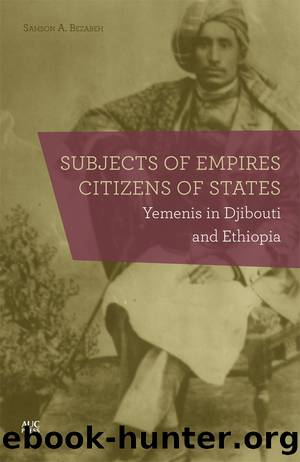Subjects of EmpiresCitizens of States by Samson A. Bezabeh

Author:Samson A. Bezabeh [Bezabeh, Samson A.]
Language: eng
Format: epub
ISBN: 9781617977053
Barnesnoble:
Publisher: American University in Cairo Press, The
Published: 2016-05-01T00:00:00+00:00
Figure 5. The Djibouti delegation at the Arab league. (Courtesy of âAbdallah Mohamed Kamil).
The Expulsion of Yemenis: Eritrean Arabism and Anti-Arab Sentiments
In the hinterland region beyond Djibouti, Yemeni political adaptation was also affected by the events of the 1950s. Here, decolonization was not an issue, as Ethiopia had not been colonized, but pan-Arabism threatened the very existence of Yemenis.
For Yemenis, the problems relating to pan-Arabism started with the bombing of an Ethiopian airliner in Frankfurt in March 1968 by the Eritrean Liberation Front (ELF), which had launched a guerrilla war against the central government. The ELF sought independence for Eritrea, then the northernmost region of Ethiopia.73 It was supported by Arab nations that hoped to form a unified Arab homeland that would include Eritrea. From 1960 to 1963, Egypt, under President Gamal Abdel Nasser, hosted the organization and allowed it to make broadcasts from Cairo (Erlich, 1995: 130â52). Following this, the ELF obtained support from the Syrian Baath Party government, which also wanted to form an Arab homeland composed of âthat area which extends beyond the Taurus mountain, the Gulf of Basra, the Arabian sea, the Ethiopian mountains . . . the Atlantic Ocean and the Mediterranean Sea, and constituting one single complete unity in which no part therefore may be alienatedâ (Erlich, 1995: 152). The ELF was given Syrian military training at an Aleppo military base in 1952. Later, it received support from the Palestine Liberation Organization (PLO) and the Iraqi Baath Party (Erlich, 1995: 130â52).
Arabs backed the separatist groups in order to further estrange Eritrea from Ethiopia, considering it a future Arab nation. They hoped that this would give them control over the Red Sea region and, hence, allow them to confront the state of Israel, which transported its imports and exports through this area.74 The ELF was more than willing to enter these alliances because of its opposition to the government of Ethiopia, Haile Selassieâs regime, following its annexation of Eritrea.
Not surprisingly, this strategy and the actions of the ELF antagonized the Ethiopian Orthodox population and their sovereign. Encouraged by the government, a number of demonstrations were held throughout the country against Syria (which was correctly identified as the backer of the group), and against Yemenis living in the country, who were accused of sympathizing with the ELF and its Arab backers.
The first demonstration occurred in Asmara, the capital city of Eritrea. It was attended by over ten thousand people.75 The demonstrators started out from the cityâs main Queen of Sheba Stadium and marched to the compound of the governor-general. They denounced the actions of the Syrian government and the ELFâs bombing of the plane.76 They shouted slogans that emphasized Ethiopian state integrity, used anti-Syrian and anti-Arab expressions, and called for the expulsion of Arabs residing in the country.77 Toward the end of the demonstration, the marchers made speeches through their representatives and asked Eritreaâs governor, Prince Asrate Kassa, to speak to the emperor about their concerns and demands,78 including for the expulsion of Arab residents from the country.
Download
This site does not store any files on its server. We only index and link to content provided by other sites. Please contact the content providers to delete copyright contents if any and email us, we'll remove relevant links or contents immediately.
| Bahrain | Egypt |
| Iran | Iraq |
| Israel & Palestine | Jordan |
| Kuwait | Lebanon |
| Oman | Qatar |
| Saudi Arabia | Syria |
| Turkey | United Arab Emirates |
| Yemen |
Empire of the Sikhs by Patwant Singh(22193)
The Wind in My Hair by Masih Alinejad(4434)
The Templars by Dan Jones(4201)
Rise and Kill First by Ronen Bergman(4029)
The Rape of Nanking by Iris Chang(3535)
12 Strong by Doug Stanton(3065)
Blood and Sand by Alex Von Tunzelmann(2617)
The History of Jihad: From Muhammad to ISIS by Spencer Robert(2213)
Babylon's Ark by Lawrence Anthony(2079)
The Turkish Psychedelic Explosion by Daniel Spicer(1997)
No Room for Small Dreams by Shimon Peres(1994)
Gideon's Spies: The Secret History of the Mossad by Gordon Thomas(1956)
Inside the Middle East by Avi Melamed(1947)
The First Muslim The Story of Muhammad by Lesley Hazleton(1889)
Arabs by Eugene Rogan(1846)
Bus on Jaffa Road by Mike Kelly(1791)
Come, Tell Me How You Live by Mallowan Agatha Christie(1774)
Kabul 1841-42: Battle Story by Edmund Yorke(1653)
Citizen Strangers by Robinson Shira N.;(1539)
